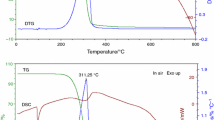Abstract
The thermal decomposition processes for ten pyrimidine nucleoside analogs were measured with thermogravimetry and differential scanning calorimetry. The IR spectra, high-performance liquid chromatography, and liquid chromatography–mass spectrometry of pyrimidine nucleoside analogs and their residues of thermal decomposition at various temperatures were determined. The molecular bond orders of pyrimidines and pyrimidine nucleoside analogs were calculated with an ab initio method from the GAMESS program. We then discuss mechanisms of thermal decomposition in these pyrimidine nucleoside analogs. The results indicate that there are four types of mechanisms. The decomposition mechanism depends on the relative strength of the peptide bond and the amide bond within pyrimidine ring and whether or not accompanied by oxidation reaction. The substituent groups affect the thermal stability and the thermal decomposition mechanism of pyrimidine nucleoside analogs. Increasing the number of electron-donating groups on the pyrimidine ring and furan ring will enhance the peptide bond, and will elevate the temperature of thermal decomposition. There is a positive correlation between the molecular bond orders calculated by quantum chemistry and the thermal decomposition temperature of pyrimidine nucleoside analogs. The stronger the weakest bond order, the higher the decomposition temperature. The molecular bond orders thus can be used as a basis to judge molecular thermal stability for analog compounds with similar molecular structure, size, and energy.















Similar content being viewed by others
References
Clercq ED. A 40-year journey in search of selective antiviral chemotherapy. Annu Rev Pharmacol Toxicol. 2011;51:1–24.
Galmarini CM, Jordheim L, Dumontet C. Pyrimidine nucleoside analogs in cancer treatment. Expert Rev Anticancer Ther. 2003;3:717–28.
Wikipedia. The free encyclopedia. Zidovudine. http://www.en.wikipedia.org/wiki/Zidovudine.
Wright K. AIDS therapy. first tentative signs of therapeutic promise. Nature. 1986;323:283.
Brook I. Approval of zidovudine (AZT) for acquired immunodeficiency syndrome. J Am Med Assoc. 1987;258:1517.
Liu Y, Lin J, Zheng YG, Zhu BQ. Application of zidovudine in cancer therapy. World Clin Drugs. 2012;33:311–3.
Wikipedia. The free encyclopedia. Stavudine. http://www.en.wikipedia.org/wiki/Stavudine.
Clercq ED. Perspectives for the chemotherapy of AIDS. Chemioterapia. 1988;7:357–64.
Lea AP, Faulds D. Stavudine: a review of its pharmacodynamic and pharmacokinetic properties and clinical potential in HIV infection. Drugs. 1996;51:846–64.
Wikipedia. The free encyclopedia. Lamivudine. http://www.en.wikipedia.org/wiki/Lamivudine.
Bernard B, deceased, Nghe N-B. Use of 1,3-oxathiolane nucleoside analogues in the treatment of hepatitis B. U.S.P. 5532246; 1996.
Perry CM, Faulds D. Lamivudine: a review of its antiviral activity, pharmacokinetic properties and therapeutic efficacy in the management of HIV infection. Drugs. 1997;53:657–80.
Wikipedia. The free encyclopedia. Telbivudine. http://www.en.wikipedia.org/wiki/Telbivudine.
Lai CL, Leung N, Teo EK, Tong M, Wong F, Hann HW, Han S, Poynard T, Myers M, Chao G, Lloyd D, Brown NA. A 1-year trial of telbivudine, lamivudine, and the combination in patients with hepatitis B e antigen-positive chronic hepatitis B. Gastroenterology. 2005;129:528–38.
Wang XJ, You JZ. Mechanism and kinetics of thermal decomposition of lamivudine. J Shenyang Pharm Univ. 2010;27:610–4.
Wang XJ, You JZ. Thermal decomposition mechanism and kinetics of stavudine. Chin J Appl Chem. 2011;28:709–15.
Wang XJ, You JZ. Mechanism and kinetics of thermal decomposition of telbivudine. J Anal Appl Pyrol. 2014;108:228–33.
Wang XJ, You JZ. Mechanism and kinetics of thermal decomposition of brivudine. Chin Pharm J. 2014;49(10):899–904.
Wang XJ, You JZ. Mechanism of thermal decomposition of zidovudine studied by TGA-FTIR. J Zhejiang Int Stud Univ. 2013;122:1–6.
Schmidt MW, Baldridge KK, Boatz JA, Elbert ST, Gordon MS, Jensen JH, Koseki S, Matsunaga N, Nguyen KA, Su S, Windus TL, Dupuis M, Montgomery JA. General atomic and molecular electronic structure system. J Comput Chem. 1993;14:1347–63.
Zhuravlev Y, Kravchenko NG, Obolonskaya OS. The electronic structure of alkali metal oxides. Russ J Phys Chem B. 2010;4(1):20–8.
Alexeev Y, Mazanetz MP, Ichihara O, Fedorov DG. GAMESS as a free quantum-mechanical platform for drug research. Curr Top Med Chem. 2012;12(18):2013–33.
Matos MAR, Sousa CCS, Morais VMF. Thermochemistry of chromone- and coumarin-3-carboxylic acid. J Therm Anal Calorim. 2010;100:519–26.
Zayed MA, Hawash MF, Fahmey MA, El-Gizouli AMM. Investigation of ibuprofen drug using mass spectrometry, thermal analyses, and semi-empirical molecular orbital calculation. J Therm Anal Calorim. 2012;108:315–22.
Keshavarz MH, Zohari N, Seyedsadjadi SA. Validation of improved simple method for prediction of activation energy of the thermal decomposition of energetic compounds. J Therm Anal Calorim. 2013;114:497–510.
El-Gamel NEA, Hawash MF, Fahmey MA. Structure characterization and spectroscopic investigation of ciprofloxacin drug. J Therm Anal Calorim. 2012;108:253–62.
Radchenko ED, Sheina GG, Smorygo NA, Blagoi YP. Experimental and theoretical studies of molecular structure features of cytosine. J Mol Struct. 1984;116:387–96.
Alemán C. The keto–amino/enol tautomerism of cytosine in aqueous solution. A theoretical study using combined discrete/self-consistent reaction field models. Chem Phys. 2000;253:13–9.
Acknowledgements
This study was financially supported by Zhejiang Provincial Government of China (No. 2011C11032), and Zhejiang International Studies University (No. 07029005).
Author information
Authors and Affiliations
Corresponding author
Rights and permissions
About this article
Cite this article
Wang, XJ., You, JZ. Study on the molecular structure and thermal stability of pyrimidine nucleoside analogs. J Therm Anal Calorim 120, 1009–1025 (2015). https://doi.org/10.1007/s10973-014-4362-6
Received:
Accepted:
Published:
Issue Date:
DOI: https://doi.org/10.1007/s10973-014-4362-6




